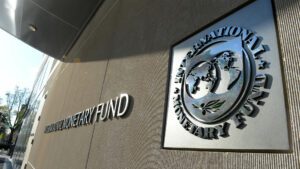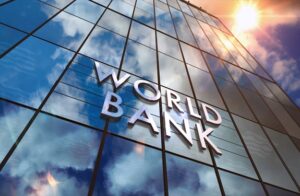2022-2024 goods trade balance forecast (USD billion)

NBU

The International Monetary Fund (IMF) left unchanged its July forecast for global economic growth in 2022 – 3.2% (in January, an increase of 4.4% was expected, in April – by 3.6%). For 2023, the estimate is lowered to 2.7% from 2.9% in July and 3.6% in April (in January, the IMF predicted global GDP growth of 3.8%).
“The global economy continues to face serious challenges caused by the lingering impact of three powerful forces: the Russian invasion of Ukraine, the “cost of living crisis” caused by persistent and increasing inflationary pressures, and the slowdown in China. (…) GDP of countries representing more than a third of the world economy will contract in 2023, while the three largest economies – the US, the European Union and China – will continue to slip. In short, the worst is yet to come, and for many, 2023 will feel like a recession,” the report says.
Russia’s war against Ukraine has triggered an energy crisis in Europe that is drastically increasing the cost of living and hindering economic activity, the IMF writes. “Gas prices in Europe have more than quadrupled since 2021, with Russia cutting deliveries to less than 20% of 2021 levels, raising the possibility of power shortages next winter and beyond. More broadly, the war has also pushed up food prices on world markets, despite the recent decline in prices following the Black Sea grain deal, which has caused severe hardship for low-income families around the world, especially in low-income countries.
The report also notes that sustained and rising inflationary pressures have caused a rapid and synchronized tightening of monetary conditions, along with strong dollar appreciation against most other currencies. “Tighter global monetary and financial conditions will affect the economy, reducing demand and helping to gradually curb inflation. However, so far, price pressures remain quite persistent and are of great concern to policymakers. We expect global inflation to peak at the end of 2022, but will remain high for longer than previously expected, falling to 4.1% by 2024.
COUNTRY ASSESSMENTS
The IMF insignificantly, but still improved its forecast for the growth of the economies of emerging markets and developing countries for 2022 – to 3.7% from 3.6% (in April it expected 3.8%), for 2023 – lowered to 3. 7% from 3.9% (April – 4.4%).
The growth forecast for the Chinese economy this year has been worsened to 3.2% from 3.3% (in April, an increase of 4.4% was expected, in January – by 4.8%), in 2023 – to 4.4% from 4 .6% (April estimate – 5.1%).
India’s GDP growth estimate has also been reduced to 6.8% from 7.4% (April – 8.2%) in 2022, and remained unchanged for 2023 – 6.1% (April – 6.9%).
At the same time, the growth forecast for the Brazilian economy has been significantly increased for 2022 – up to 2.8% from 1.7% in July and 0.8% in April, for 2023 it has also been increased – up to 1% from up to 0.9% (April forecast – 1.4%).
The estimate of GDP growth in developed countries in 2022 is worsened by 0.1 percentage points – up to 2.4% (April – 3.5%) and by 0.3 percentage points. – up to 1.1% – in 2023 (2.4% – April estimate).
The IMF continued to reduce the forecast for US GDP growth in 2022 – by 0.7 percentage points. to 1.6% (April – 3.7%). The following year, the estimate remained the same – 1% (April – 2.3%).
The economy of the eurozone countries this year, according to the IMF, will grow by 3.1%, the forecast has been improved from 2.6% in July and 2.8% in April). For 2023, the estimate is downgraded by 0.7 p.p. – up to 0.5% (April – 2.3%).
Italy’s 2022 GDP growth forecast has been raised to 3.2% from 3% in July and 2.3% in April. In 2023, the IMF expects the economy to decline by 0.2%, in July it predicted an increase of 0.7%, in April – by 1.7%.
The German economy in 2022 will grow, according to the IMF, only by 1.5% (better than the July forecast – 1.2%). At the same time, in 2023, the economy is expected to decline by 0.3% (in July, an increase of 0.8% was expected, in April – by 2.7%).
The forecast for Spain for the current year has been raised to 4.3% from 4% (in April – 4.8%) and lowered to 1.2% from 2% in 2023.
For France, the estimate for the current year has been improved to 2.5% from 2.3% and by 0.4 percentage points, for 2023 it has been worsened to 0.7% from 1%.
The growth forecast for the UK economy for 2022 has been improved to 3.6% from 3.2%, for 2023 it has been worsened to 0.3% from 0.5%. Japan’s GDP growth estimate for the current year remained at the level of 1.7%, for 2023 it decreased to 1.6% from 1.7%.

In its August report, the US Department of Agriculture (USDA) increased the forecast for the harvest of Ukrainian corn in 2022/2023 marketing year (MY, July-June) compared to July by 5 million tons – up to 30 million tons from 25 million tons, and its export estimate has been raised by 3.5 million tons to 12.5 million tons from 9 million tons.
According to a report on the website of the US Department of Agriculture, the estimate of domestic corn consumption in Ukraine has been increased by 1 million tons – from 9.5 million tons to 10.5 million tons.
In the new forecast, the agency also increased the forecast for wheat exports from Ukraine in 2022/2023 MY by 1 million tons – up to 11 million tons from 10 million tons, while the assessment of its harvest remained at the same level – 19.5 million tons. At the same time, the forecast for its domestic consumption in Ukraine was also left at the same level of 10.2 million tons.
In addition, the forecast for carry-over stocks of wheat at the end of the current marketing year has been reduced – from 5.24 million tons to 4.24 million tons compared to 5.84 million tons at its beginning.
According to the report, in general, the forecast for the feed grain harvest in Ukraine for 2022/23 MY was increased by 5.7 million tons – up to 37.46 million tons from 31.76 million tons, and its export – by 3.5 million tons, up to 14 .33 million tons from 10.83 million tons.
As reported, since the beginning of MY 2022/2023, Ukraine has exported 2.21 million tons of grain and leguminous crops, which is 2.1 times less than in the previous MY. The country supplied to foreign markets 1.45 million tons of corn (26.1% more than in 2021/2022 MY), 562 thousand tons of wheat (3.2 times less), 192 thousand tons of barley (8.4 times less) and 5.1 thousand tons of flour (3.2 times less).

The forecast for the harvest of grain and oilseeds in Ukraine this season has been improved by approximately 5-7 million tons – up to 65-67 million tons from 60 million tons, according to the website of the government portal on Wednesday.
It is specified that the increase in the harvest forecast was announced by the Minister of Agrarian Policy and Food Mykola Solsky during a conference call between Prime Minister Denys Shmyhal and the heads of regions.
In turn, the Prime Minister noted that in the context of the Russian military invasion in Ukraine, 12 million tons of new crop grain have already been harvested from a total area of 3.5 million hectares.
Shmyhal also announced the emergence of additional opportunities for grain exports due to the unblocking of the Odessa seaport under the Istanbul Agreement on the export of agricultural products from Ukraine, concluded on July 22 under the auspices of the UN.
“In total, in June we exported 3.2 million tons out of 5 million tons (pre-war monthly volumes – IF-U) that were required. Exports are gradually growing both by rail, by road, and through the Danube ports. Sea ports will significantly expand these opportunities and farmers will receive new opportunities for the sale of products. The state is doing everything necessary for this,” the Prime Minister’s government portal quotes.
Shmygal also noted the recently introduced grant program for the development of horticulture, greenhouses, the development of processing and micro-enterprises, under which over 5,000 applications have already been submitted and processed, and this week the first applicants will receive state support.
As reported, the US Department of Agriculture in the July report predicts the harvest of Ukrainian wheat in the 2022/2023 marketing year (MY, July-June) at the level of 19.5 million tons, its export – 10 million tons, domestic consumption within the country – 10.2 million tons . The corn harvest is estimated at 25 million tons, export – 9 million tons, domestic consumption – 10.7 million tons.
In early July, the Ukrainian Grain Association (UGA) increased the forecast for the harvest of grains and oilseeds in Ukraine in 2022 by 4.4% compared to the May forecast, to 69.4 million tons from 66.5 million tons.
According to her forecasts, in 2022 the wheat harvest is expected at the level of 20.8 million tons (+8.3% to the organization’s May forecast); 27.3 million tons of corn (+4.6%); 6.6 million tons of barley (forecast kept); 9 million tons of sunflower (forecast kept); 2.2 million tons of soybeans (+4.7%); 1.5 million tons of rapeseed (+13.3%).

The World Bank has downgraded its inflation forecast for Ukraine to 20% by the end of 2022 from its April forecast of 15% inflation, Arup Banerji, World Bank Regional Country Director for Eastern Europe (Belarus, Moldova and Ukraine), has told Interfax-Ukraine.
“Inflationary pressures are rising. Consequently, at this stage, inflation is expected to continue rising and could reach 20% in December against 15% in our April forecasts,” Banerji said in an exclusive interview with Interfax-Ukraine.
Banerji said that the rise in inflationary pressure is particularly because of the need to cover budgetary requirements in March-May.
“International partners have acknowledged the financial challenges, thus they have committed around $20 billion in financial assistance to Ukraine. Despite these significant commitments, the timing of repayments will continue to be critical in order to meet Ukraine’s current needs,” the World Bank regional director said.
The World Bank has also maintained its forecast for a sharp contraction of 44% in Ukraine’s GDP in 2022.
“However, owing to the length of the war, when hostilities continue in several regions of Ukraine, we cannot be sure of our preliminary forecasts for a recovery in the medium term relatively,” Banerji said.

The World Trade Organization (WTO) has downgraded its forecast for global trade growth in 2022 from 4.7% (in the October version) to 3.0%, noting that the Russian war against Ukraine threatens the fragile recovery of world trade, the WTO report says. published on Tuesday.
The outlook for the global economy deteriorated after Russia’s invasion of Ukraine, “prompting WTO economists to reconsider their forecasts for world trade for the next two years,” the paper notes.
The organization now expects merchandise trade to grow by 3.0% in 2022, below its previous forecast of 4.7%, and by 3.4% in 2023. But these estimates are less accurate than usual because for the changing nature of the war, the authors of the review note.
“The most rapid economic impact of the crisis has been a sharp rise in commodity prices. Despite their small shares in global trade and manufacturing, Russia and Ukraine are key suppliers of essential commodities, including food, fuel and energy products and fertilizers, the supply of which is now Grain deliveries through the Black Sea ports have already been stopped, which could lead to serious consequences for the food security of poor countries,” the WTO said.